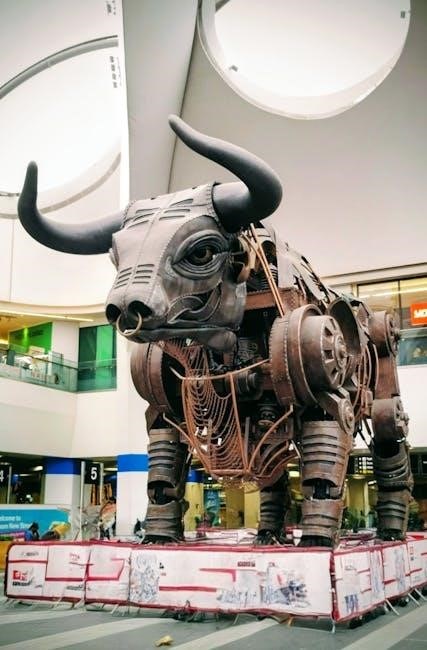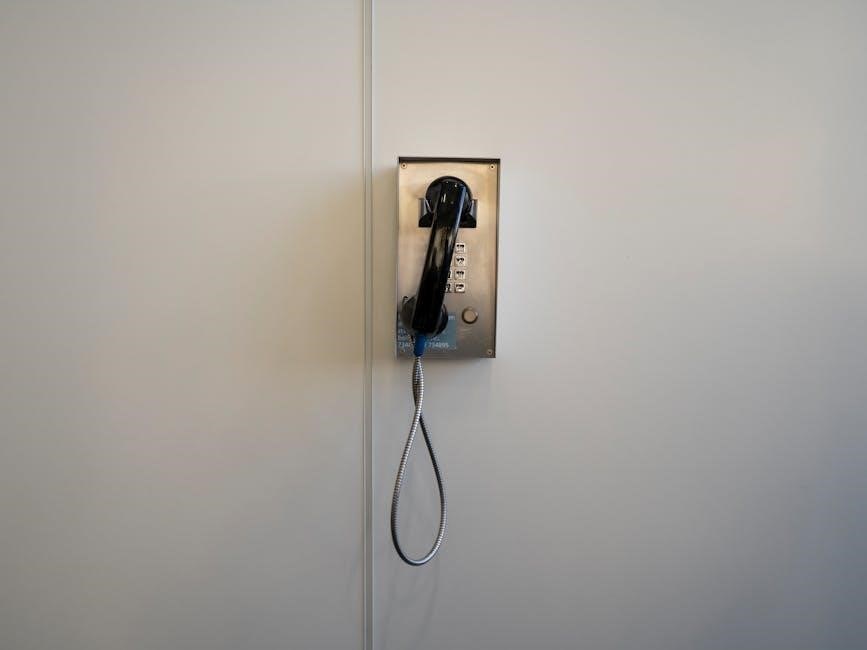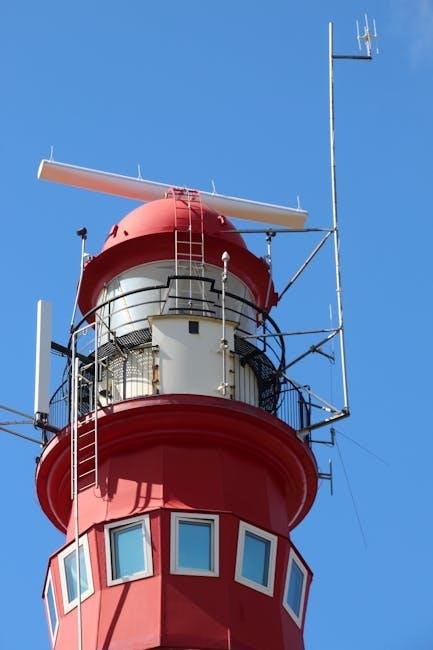Metal roofing installation has gained popularity due to its durability and cost-effectiveness. This guide provides a comprehensive overview of the process, benefits, and best practices for installing metal roofs.
1.1 Overview of Metal Roofing Benefits
Metal roofing offers numerous advantages, making it a popular choice for both residential and commercial projects. Its durability ensures long-lasting performance, resisting weather, fire, and pests effectively. With a lifespan often exceeding 30 years, metal roofs provide exceptional value. They are low maintenance, requiring minimal repairs and upkeep. The material’s strength allows it to withstand heavy rains, hail, and extreme temperatures. Additionally, metal roofs are fire-resistant and can be designed to meet specific fire safety codes. Their lightweight nature reduces structural stress, and they can be installed over existing roofs in some cases. Metal roofs are also eco-friendly, as many are made from recyclable materials. Furthermore, they offer noise reduction benefits and can be energy-efficient, reflecting solar rays and reducing cooling costs. These benefits make metal roofing a versatile and sustainable option for modern construction needs.
1.2 Importance of Proper Installation
Proper installation is crucial for ensuring the performance and longevity of a metal roof. Improper techniques can lead to leaks, structural damage, and compromised safety. A well-executed installation ensures that the roof withstands environmental stresses and maintains its integrity. It also guarantees compliance with manufacturer warranties and local building codes. Proper installation involves precise measurements, secure fastening, and correct handling of materials. Additionally, safety protocols must be followed to prevent accidents during the process. A professional installer with experience in metal roofing is essential to achieve a flawless finish and maximize the roof’s benefits. Correct installation not only enhances the roof’s aesthetic appeal but also ensures long-term durability and functionality.

Preparation and Planning
Preparation and planning are critical for a successful metal roofing installation. This includes site preparation, measuring the roof, calculating materials, and understanding roof pitch and design.
2.1 Site Preparation and Safety Measures
Proper site preparation and safety measures are essential before starting metal roofing installation. Clear the area of debris and ensure the roof structure is inspected for damage or rot. Secure scaffolding and ensure stable access to the roof. Wear personal protective equipment, including hard hats, safety glasses, and harnesses. Ensure proper ventilation to prevent moisture buildup. Check for power lines and ensure tools are insulated. Train all workers on safety protocols and emergency procedures. Use non-slip shoes and maintain a clean workspace to prevent accidents. Ensure fire extinguishers are nearby, especially when cutting materials that generate sparks. Regularly inspect equipment and scaffolding for stability and safety compliance.

2.2 Measuring the Roof and Calculating Materials
Accurate measurement of the roof is crucial for a successful metal roofing installation. Start by measuring the roof’s length, width, and pitch to determine the total area. Use a tape measure to assess valleys, ridges, and eaves. Calculate the number of panels needed based on the manufacturer’s specifications and the roof’s dimensions. Include measurements for flashing, underlayment, and fasteners. Add 10% to the total material list to account for waste and cuts. Double-check calculations to avoid shortages or overstocking. Use a calculator or software to simplify complex roof geometries. Ensure all measurements align with the roof’s design and pitch for proper fitment and functionality.
2.3 Understanding Roof Pitch and Design
Roof pitch refers to the slope of the roof, typically expressed as a ratio of rise to run (e.g., 4:12). Understanding the roof pitch is essential for metal roofing installation, as it affects drainage, material selection, and installation techniques. A steeper pitch may require specific fastening methods or panel types to ensure water runs off efficiently. The design of the roof, including hips, valleys, and ridges, must align with the pitch to prevent leaks and structural issues. Measure the pitch accurately using a level or pitch gauge, and consult local building codes to ensure compliance. Properly matching the roof design to its pitch ensures long-term durability and weather resistance.

Tools and Materials Needed
Metal roofing installation requires specific tools like a tape measure, level, screw gun, metal snips, and ladder. Essential materials include metal panels, fasteners, underlayment, flashing, and sealants.
3.1 Essential Tools for Metal Roofing Installation
Metal roofing installation requires specialized tools for accuracy and efficiency. A tape measure and level ensure precise measurements and alignment. A screw gun or impact driver is essential for securing panels. Metal snips or a nibbler are needed for cutting panels to size. A ladder or scaffolding provides safe access to the roof. A utility knife is handy for trimming underlayment. A chalk line helps mark straight lines for panel alignment. Safety gear, such as gloves and safety glasses, is crucial. Optional tools include a seam locker for standing seam roofs and a drill for pre-drilling holes. Using the right tools ensures a professional finish and prevents damage to materials.
3.2 Required Materials and Fasteners
The materials needed for metal roofing installation include durable metal panels, underlayment, and moisture barriers. High-quality fasteners, such as screws with rubber washers, are essential for securing panels and preventing leaks. Additional materials like flashing for valleys and vents ensure weather-tight seals. Ridge caps and edge trim complete the roof’s finish. Fasteners must be compatible with the roofing material to avoid corrosion. Sealants and gaskets are used to reinforce gaps and joints. manufacturers often provide specific fastening systems, so it’s important to follow their recommendations. Proper materials and fasteners ensure structural integrity and long-term performance of the metal roof.

Step-by-Step Installation Process
The step-by-step installation process involves removing the old roof, installing underlayment, aligning panels, fastening securely, sealing valleys, and finishing with ridge caps for a durable finish.
4.1 Removing the Old Roof (If Applicable)
Before installing a metal roof, ensure the existing roof is removed if necessary. Start by inspecting the roof for loose or damaged materials. Use tools like pry bars, shovels, or roof tear-off tools to carefully strip off shingles, tiles, or other roofing materials. Protect the surrounding areas, including landscaping and siding, from falling debris using tarps or drop cloths. Remove all flashing and vents to prepare the roof deck for inspection. After removal, inspect the roof deck for rot or damage and repair it before proceeding with the installation. Properly dispose of all materials, following local regulations. Safety gear, such as gloves and safety glasses, is essential during this process.
4.2 Installing Underlayment and Moisture Barriers
Installing underlayment and moisture barriers is crucial for a durable and weather-tight metal roofing system. Begin by rolling out the underlayment material, ensuring it covers the entire roof deck. Use synthetic underlayment or felt paper, securing it with staples or nails. Overlap seams by at least 6 inches and ensure tight fitting around vents and edges. Apply a moisture barrier, such as a peel-and-stick membrane, along eaves, valleys, and around penetrations to prevent water infiltration. Cut materials to size, fitting them snugly without wrinkles. Ensure all edges are sealed to create a continuous barrier. This layer protects the roof deck from moisture and provides a smooth surface for metal panels. Proper installation ensures long-term performance and prevents costly repairs.
4.3 Starting the Installation: Edge and Eave Details
Starting the installation at the edges and eaves is critical for a secure and weather-tight metal roofing system. Begin by measuring the eave height to ensure accurate panel cutting. Cut the metal panels to fit snugly along the eaves, leaving enough overhang to protect the fascia. Secure the panels at the edges with appropriate fasteners, ensuring alignment is precise to maintain the roof’s structural integrity. Apply weatherproof sealing at the eaves to prevent water infiltration. Properly aligning and fastening the panels at the edges is essential for the overall durability and appearance of the roof. This foundational step ensures a smooth process for subsequent installations and maintains the roof’s performance over time.
4.4 Installing Roof Panels and Aligning Them Properly
Once the underlayment and edge details are in place, begin installing the roof panels starting from the eave. Ensure the panels are aligned straight and securely fastened to the roof deck. Use chalk lines to guide the installation and maintain proper spacing between panels. Always follow the manufacturer’s recommended fastening pattern to avoid over- or under-tightening screws. Check each panel for alignment with the previous one to maintain a consistent appearance. Proper alignment prevents water from seeping between panels and ensures structural integrity. Use a level to verify panel placement and adjust as needed. Securely fasten panels at the edges and along the ribs, working from the center outward to prevent buckling. Proper installation ensures a watertight and durable roof system.
4.5 Fastening Panels Securely: Screw Patterns and Spacing
Proper fastening is critical to ensure the durability and weather-tightness of a metal roof. Use a screw gun to drive self-tapping screws through the panels and into the roof deck. Screws should be spaced evenly, typically every 12 to 24 inches, depending on the manufacturer’s recommendations. Start fastening from the eave and work upward to prevent water from seeping under the panels. Align screws with the panel’s corrugations or ribs to maintain structural integrity. Avoid over-tightening, as this can damage the panels or their protective coating. Follow the recommended screw pattern to distribute weight evenly and prevent buckling. Always refer to the manufacturer’s guidelines for specific screw spacing and patterns to ensure a secure and long-lasting installation.
4.6 Handling Valleys and Vents in Metal Roofing
Valleys and vents require special attention during metal roofing installation to ensure proper water flow and ventilation. Start by installing a valley pan or flashing in the valley area to direct water smoothly toward the gutter. Secure the pan firmly to prevent shifting. For vents, cut openings carefully to fit the vent pipe or chimney, ensuring they are centered; Use specialized flashing or weather-tight boots around vents to maintain a watertight seal. Avoid overlapping panels directly over vents, as this can compromise structural integrity. Properly sealing these areas prevents leaks and ensures adequate airflow. Follow manufacturer instructions for vent installation to maintain roof performance and durability over time.
4.7 Installing Ridge Caps and Finishing Touches
Installing ridge caps is the final step in securing the roof’s peak and ensuring a watertight seal. Measure and cut the ridge cap to fit the roof’s length, aligning it with the panels. Secure the cap using screws spaced evenly, following the manufacturer’s recommendations. Next, address any gaps or openings around vents, chimneys, or skylights with flashing or sealant. Inspect the entire roof for loose panels or fasteners and tighten as needed. Apply touch-up paint to any scratched or exposed metal. Finally, perform a visual inspection to ensure all elements are properly aligned and sealed. This step ensures a polished finish and long-term performance of the metal roofing system.

Safety Considerations
Safety is paramount in metal roofing installation. Wear protective gear, including helmets, safety glasses, and gloves. Ensure proper fall protection with harnesses and secure ladder placement. Always maintain three points of contact when climbing. Use tools responsibly and avoid overreaching. Keep the workspace clean to prevent tripping hazards. Adhere to local building codes and manufacturer guidelines to minimize risks and ensure a safe working environment throughout the installation process.
5.1 Best Practices for Safe Roofing Work
Ensuring safety is critical during metal roofing installation. Always wear appropriate personal protective equipment, including safety glasses, gloves, and sturdy footwear. Conduct a thorough site inspection to identify potential hazards. Use proper ladder safety techniques and maintain three points of contact. Keep tools and materials organized to avoid tripping. Avoid working in adverse weather conditions like heavy rain or strong winds. Ensure proper ventilation and lighting in the workspace. Never overload roofing sections or tools, and avoid overreaching, which can lead to loss of balance. Regularly inspect equipment for damage and ensure all team members are trained in safety protocols. Communication among workers is key to preventing accidents and ensuring smooth operations.
5.2 Fall Protection and Harness Use
Fall protection is paramount during metal roofing installation. Always use a properly fitted safety harness with securely attached lanyards or ropes. Ensure anchor points are sturdy and meet safety standards. Inspect harnesses and ropes for wear or damage before use. Properly train all workers on harness use and emergency procedures. Supervise less experienced team members to ensure compliance. Never work near unprotected roof edges without fall protection. Position safety nets or air cushions below if feasible. Regularly review and update fall protection strategies based on site conditions. Compliance with local safety regulations is non-negotiable to prevent accidents and ensure a secure working environment throughout the installation process.
5.3 Ladder Safety and Proper Handling
Ladder safety is critical during metal roofing installation. Always select a ladder that meets the task’s height requirements and weight capacity. Inspect ladders for damage, such as cracks or worn rungs, before use. Place ladders on firm, level surfaces and secure them if possible. Maintain three-point contact by keeping two hands and one foot, or two feet and one hand, on the ladder at all times. Avoid overreaching; move the ladder instead. Have a helper stabilize the ladder when working on uneven or slippery surfaces. Never leave tools or materials unattended on ladders. Regularly inspect and maintain ladders, and follow manufacturer guidelines for safe use. Proper ladder handling prevents accidents and ensures a secure working environment.

Maintenance and Repair
Regular inspections and cleaning are essential for metal roof longevity. Address leaks promptly, repair dented panels, and re-tighten fasteners. Use compatible materials to prevent damage. Schedule professional inspections for complex issues to ensure durability and safety.
6.1 Regular Inspection and Cleaning
Regular inspections of your metal roof are crucial to ensure its longevity and performance. Start by examining the roof for debris, such as leaves or branches, which can cause damage or clog drainage systems. Check fasteners for tightness and panels for signs of damage, dents, or scratches. Clean the roof surface using a pressure washer with a low setting and mild detergent to remove dirt, grime, and mildew. Avoid harsh chemicals or abrasive materials that could harm the finish. Inspect gutters and downspouts to ensure proper water flow. Schedule inspections at least twice a year, ideally in spring and fall, to maintain your roof’s integrity and prevent potential issues. Regular cleaning and maintenance will help preserve the roof’s appearance and durability, ensuring it remains rust-resistant and weather-tight for years to come. Always prioritize safety during inspections by using proper equipment and considering professional assistance for complex tasks.
6.2 Addressing Leaks and Damaged Panels
Identifying and addressing leaks or damaged panels promptly is essential to prevent further damage to your metal roof. Start by inspecting the roof for signs of leaks, such as water stains or rust spots. If a leak is found, locate its source by tracing it back to the roof surface. Damaged panels, whether dented, scratched, or punctured, should be repaired or replaced immediately. Clean the affected area thoroughly before applying a compatible sealant or patching compound. For severely damaged panels, remove and replace them with new ones, ensuring proper alignment and secure fastening. Always use manufacturer-recommended materials to maintain warranty validity and structural integrity. If the issue is extensive, consider consulting a professional to avoid further complications.
6.3 Re-tightening Fasteners Over Time
Over time, fasteners on metal roofs may loosen due to thermal expansion, contraction, or weather-related stress. Regularly inspecting and re-tightening these fasteners is crucial to maintain the roof’s integrity and prevent leaks. Start by examining the roof after extreme weather events or seasonal changes. Use a torque wrench to tighten loose screws or bolts, ensuring not to over-tighten, which could damage the panels or underlying structure. Additionally, inspect the rubber gaskets for wear and replace them if necessary. Schedule annual inspections to address potential issues early. Always follow the manufacturer’s recommendations for torque specifications and fastener maintenance to ensure long-term durability and performance of your metal roof.

Manufacturer Instructions and Warranties
Adhering to manufacturer instructions ensures proper installation and warranty validity. Follow guidelines for torque specifications, sealing methods, and material usage. Annual inspections maintain compliance and optimal performance.
7.1 Following Manufacturer Guidelines
Strictly adhering to manufacturer guidelines is crucial for a successful metal roofing installation. These instructions are tailored to specific materials and systems, ensuring compatibility and performance. Always review the manual thoroughly before starting the project; Pay close attention to recommended tools, torque specifications, and sealing methods. Deviate only when necessary and document any modifications. Manufacturer guidelines also outline warranty requirements, so compliance is essential to maintain coverage. Highlight critical steps and refer back to the manual during installation. Properly organized materials and pre-drilled holes, as specified, prevent errors. Following these instructions ensures a durable, weather-tight roof that meets safety and quality standards for years to come.
7.2 Understanding Warranty Terms and Conditions
Understanding warranty terms and conditions is essential for protecting your investment in a metal roofing system. Most manufacturers offer warranties covering material defects and workmanship for a specified period. Review the warranty document to identify coverage limits, exclusions, and maintenance requirements. Weather-related damage, improper installation, and lack of maintenance are common exclusions. Ensure all installations comply with manufacturer guidelines to avoid voiding the warranty. Keep records of installation, inspections, and repairs for warranty claims. Some warranties may transfer to new owners, enhancing property value. Always register your warranty and understand the process for filing claims. Ignoring warranty terms can lead to costly repairs not covered by the manufacturer.

Troubleshooting Common Issues
Metal roofing systems are durable, but issues like leaks, dents, or noise can arise. Identify the root cause, such as loose fasteners or damaged panels, and address promptly. Always refer to the manufacturer’s troubleshooting guide for specific solutions. Regular inspections and timely repairs prevent minor problems from escalating. Noise issues often result from thermal expansion or improper installation. Addressing these problems early ensures long-term performance and maintains the roof’s integrity. Keep a maintenance log to track repairs and replacements for future reference. Professional assistance may be needed for severe or complex issues. Routine checks are key to preventing costly damages.
8.1 Dealing with Noisy Roof Panels
Noisy metal roof panels can be frustrating, especially during rainfall or hail. The primary cause is often thermal expansion and contraction, which creates popping or cracking sounds. This is typically normal but can be minimized. Ensure panels are installed with adequate expansion joints to allow for movement. Tightening or loosening fasteners may also help, but avoid over-tightening, as this can damage the panels. Additionally, rain noise can be reduced by installing a sound-dampening underlayment or insulation beneath the metal roofing. Regular inspections can help identify loose fasteners or misaligned panels contributing to the noise. Addressing these issues promptly ensures a quieter and more durable roofing system. Proper installation and maintenance are key to minimizing noise concerns.
8.2 Fixing Dented or Scratched Panels
Metal roofing panels can sometimes develop dents or scratches due to weather, debris, or installation errors. To fix minor dents, use a rubber mallet to gently tap the panel back into shape from the underside. For scratches, apply metal touch-up paint to prevent rust and maintain the roof’s appearance. If the damage is extensive or affects the panel’s structural integrity, replace the panel entirely. When replacing, ensure proper alignment with adjacent panels and secure it with the correct fasteners. Always follow manufacturer guidelines for repair materials and techniques. Regular inspections can help identify and address minor issues before they escalate, ensuring the roof remains durable and visually appealing. Timely repairs prevent further damage and maintain the roof’s performance.

8.3 Resolving Fastener-Related Problems
Fastener-related issues, such as loose screws or over-tightened fasteners, are common in metal roofing. To address these, inspect the roof for any gaps or unevenness around the fasteners. For loose screws, tighten them using a torque screwdriver, ensuring not to over-tighten, which can damage the panel or gasket. If a fastener is stripped or rusted, replace it with a new one, ensuring it matches the manufacturer’s specifications. Additionally, check for proper alignment of the panels, as misalignment can cause fastener stress. For over-tightened fasteners, slightly loosen them and re-tighten to the recommended torque. Regularly inspect all fasteners to prevent leaks and ensure the roof’s structural integrity. Always follow the manufacturer’s guidelines for fastener replacement and tightening to avoid further issues.
Proper metal roofing installation ensures durability and protection. Follow this guide for a professional finish, and maintain your roof for long-lasting performance and structural integrity.
9.1 Final Check and Inspection
A thorough final inspection is crucial to ensure the metal roofing installation meets quality and safety standards. Check all panels for proper alignment, secure fasteners, and even spacing. Verify that ridge caps, valleys, and vents are sealed tightly. Ensure underlayment and moisture barriers are intact and no gaps exist. Inspect for any dents, scratches, or loose components. Test the roof’s integrity by checking for leaks during light rain or using a hose. Confirm that all manufacturer guidelines have been followed. This final step ensures long-term durability, prevents future issues, and guarantees the roof’s performance under various weather conditions.
9.2 Tips for Long-Term Durability
To ensure long-term durability, regular maintenance is essential. Schedule annual inspections to identify and address potential issues early. Clean debris from the roof surface and gutters to prevent damage and ensure proper water flow. Avoid using abrasive cleaners or harsh chemicals, as they can damage the finish. Tighten loose fasteners periodically to maintain structural integrity. Protect the roof from extreme weather by trimming nearby tree branches and securing outdoor furniture. Apply a protective coating if recommended by the manufacturer to enhance resistance to rust and fading. By following these tips, you can extend the lifespan of your metal roof and maintain its aesthetic appeal and functionality for decades.